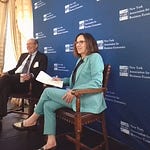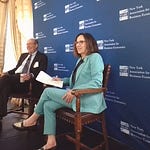Jason Furman gave me a very interesting answer when I asked him to step back from weaker than forecast payrolls, a tick down in unemployment, and another month of strong wages growth and tell me, What is the message from the August jobs report?
This is the report that has been eagerly expected by markets and economists to cement the September rate cut Fed chair Jay Powell “all but announced” in his recent Jackson Hole Kansas City Fed Symposium speech, and maybe even signal how big that cut will be. What is it telling us, and the Fed?
It’s important to note first of all that Jason is an esteemed professor of economics at Harvard’s John F. Kennedy School of Government. He is also former head of the Council of Economic Advisors and former deputy director at the National Economic Council in the Obama administration, after being campaign advisor to the former president in 2008. He knows how to think hard on both an academic and on a policy-making level about the economy, inflation and the forces that drive them – including the Federal Reserve. He knows how to communicate, how to put his analysis in perspective for regular people to understsand.
Jason laid out a great argument – actually arguments - to explain why he sees 100% odds of a 25 bps rate cut, and virtually no chance of a 50 bps rate cut at this month’s meeting.
And he did so today by looking at what the data are not only telling us today, but what they were telling us five years, ago, six months ago, and one day ago, and what that that means for the Fed’s reaction function now.
“In thinking about the labor market, you can step back by different amounts, Jason says. (00:01:30)
“If I step back 5 years ago, and you ask, what do I think about the economy, today I'm shocked about how many jobs there are. It's way above what I would have expected 5 years ago,” he adds. “I'm shocked at how high the prime age employment rate is higher than it was then prior to Covid. And, by the way, continuing to drift although it was flat in August.”
“Then ask me how I feel compared to 6 months ago? And not just from this report, but the totality of the data. I am much less worried about inflation than I was six months ago and I am somewhat more worried about recession, even though the unemployment rate ticked down this last month the trend has been up,” Jason adds. “The job growth has slowed. And it's an economy that in the labor market at least, has a little bit of momentum.”
Here's where Jason really surprised me (00:02:34):
“Now ask me how I've changed my views relative to yesterday (the Thursday before the big Friday jobs report),” he says.
“Relative to yesterday. I am a touch less concerned about recession, even though on balance that's still the bigger fear. Because that (August) unemployment rate ticked down. The jobs missed (but) that's so trivial. That's way within the margin of error. They just can't measure these things that well,” he says.
“And I am just a touch more worried about inflation,” he adds. “Wage growth came in pretty strong for the 4th month in a row. We're seeing wage growth. It's more like what you'd see in a 3-1/2 percent inflation economy than the (current) 2-1/2 percent half one.”
Summing up he says, “We have the big picture, probably a pretty good big picture. There's more recession risk than inflation risk. But relative to yesterday, a tiny bit more inflation risk than I thought, a tiny bit recession risk than I thought.”
What does this mean for the Fed, for a 25bps rate cut at the September meeting vs a 50 bps cut? For the total number and size of rate cuts by the end of the year?
Jason says the last time we had a look at the Fed’s reaction function was in June (when they issued their latest dot plot which showed their median forecast for GDP, unemployment, and inflation – and for the number of rate cuts this year.)
“Relative to what we had then, the unemployment rate looks like it's going to be at end the year a little bit higher than what they (Fed officials) said (in June),” he says. “The inflation rate looks like it's going to end the year a little bit lower than what they said, and GDP growth looks like it'll end the year roughly at what they said. The totality of all of that says that based on their reaction function they should probably do a bit more than the 2 cuts that they had penciled in back in June.”
Summing up, Jason says, “Now, how many cuts is it (going to be) based on these data? I'd start… with 25 basis points in September. I do not think there's any reason in these data to panic plus consumer spending remains really strong. The hard data on the business side remains very strong as well. So start with 25.”
“Your modal case is 25 at each of the next 2 meetings this year, but you know they can dial it up or down, based on the data.”
Could the latest jobs numbers, or coming inflation data, push the Fed to cut 50 bps at the coming meeting? Jason says, No.
“I just don't know what data we're gonna get in the next 12 days that would push you (the Fed to do that,” he says. “We'll get the CPI. That's not really what matters right now. There's not a whole lot of inflationary risk, even if there's a tiny little bit more than there was yesterday. So even if inflation is really tame that's not a reason you need to cut by 50. It's not like inflation is going to be too low for the fed. It'll still be, you know on the high side, not the low side.”
“So the reason that they're cutting is because employment is worse than they would like,” Jason says. “If the unemployment rate stayed at 4.2% for the rest of time and the inflation rate stayed at, you know, 2.4% for the rest of time, I think they (will) take that and lock that in and and be happy with that.
“So based on where the labor market is, the lack of rapid deterioration, the incredibly strong GDP mbers, “I don't see what they're going to see. that's going to make them nervous enough to do fifty (basis points) 12 days from now.”
We covered a whole lot more ground in this interview. Is there a chance inflation could bottom, out stall, even rise a bit? Could this spur the Fed to even raise the key rate? Jason says no. There will be no more rate hikes in this cycle. The most the Fed might do, if the economy is not going into recession, and unemployment is not ratcheting higher, and inflation plateaus at 2.5%, is to simply stop cutting rates.
As for the where the fed funds rate ends up, Jason sees it as low as 3%. He stresses that the Taylor Rule sees the need for the Fed to do a series of rate cuts. I might add that when I last spoke with Professor Taylor he was looking for a terminal funds rate of 4.0-4.5%, a good bit higher than Jason is forecasting using the same kind of rules.
As for a little bit of politics, find out what Jason —yes a Democrat - thinks the fiscal picture will look like for the Fed and all of us after the November election. He sees the broad outline of Kamala Harris’s current policy plans pushing up the budget deficit by $1 trillion, and Donald Trump’s plans pushing it up by $6 trillion. As I told Jason as we ran out of time, this question was a down payment for an interview focused on the two candidates’ platforms when we get much closer to the November election and we have a clearer sense of how the two platforms have shaped up.
So hop on board. Jason has a lot of interesting and thought-proving things to say. And I had a lot to ask.














Share this post